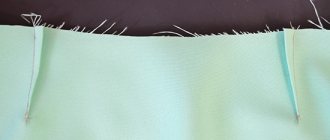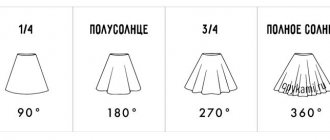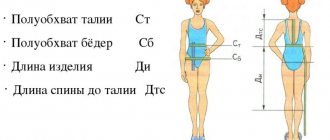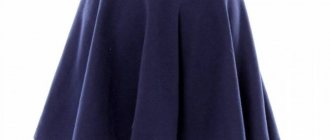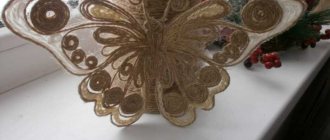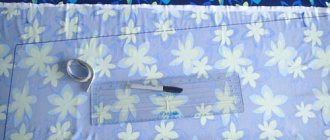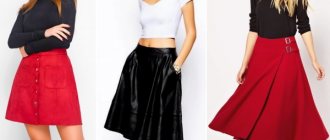Currently, oriental dances are becoming increasingly popular, and accordingly, the demand for special costumes for this type of dance is increasing. In this regard, more and more organizations and individual craftsmen are appearing who are ready to sew you such clothes for a certain fee. But often such services are quite expensive, although a skirt made specifically for oriental dances is not so difficult to make and any craftswoman with at least some sewing skills can sew such a skirt on her own.
A skirt can be sewn for oriental dances from various fabrics, from chiffon to satin. The main thing is that the fabric flows, shimmers and flies; you can also combine different fabrics in one suit, the main thing is that it all harmonizes with each other. The classic version of the skirt is two suns for the back panel and a half sun for the front panel. In this case, there is no need to sew them together, since the cuts will pass through the middle of the leg.
Also for oriental dances, fish skirts can be used, which, in fact, are year-skirts and are great for women with curves, as they visually elongate the silhouette and make it thinner. This skirt is an indispensable option for performing tabla; it well emphasizes the shaking, circles and figure eights of the hips. At the initial stage, you can use a regular straight skirt with slits on the sides for oriental dancing. The most suitable skirt length for oriental dance is two centimeters above the ankle, since during the dance the skirt can fall down a little and if the length is too long there is a danger of stepping on the skirt.
So, we have figured out the main points when sewing a skirt with your own hands for oriental dances, you can proceed directly to the master class.
Semi-sun skirt
Reduced pattern drawing:
Sizes 40-60
(differing data for different sizes are given sequentially separated by a dash)
You will need: crepe 150 cm wide and 2.05-2.10-2.15-2.20-2.20-2.25-2.30-2.35-2.35-2.40-2 long .45 m; zipper 20cm long.
Details:
1. front panel - 1 piece 2. back panel - 1 piece 3. belt - a rectangle with a length according to the table below (including 3 cm for the fastener) and a width of 6 cm (finished 3 cm).
The size of the radii R1, R2 and the length of the belt:
| size | radius R1, cm | radius R2, cm | belt, cm |
| 40 | 20,4 | 123,4 | 67 |
| 42 | 21,6 | 124,6 | 71 |
| 44 | 22,9 | 125,9 | 75 |
| 46 | 24,2 | 127,2 | 79 |
| 48 | 25,5 | 128,5 | 83 |
| 50 | 26,7 | 129,7 | 87 |
| 52 | 28,0 | 131,0 | 91 |
| 54 | 29,9 | 132,9 | 97 |
| 56 | 31,8 | 134,8 | 103 |
| 58 | 33,7 | 136,7 | 109 |
| 60 | 35,6 | 138,6 | 115 |
Layout plan for fabric 150 cm wide:
Cut:
Place the pieces on the fabric in one layer, right side up. Cut with equal seam allowances
1.5 cm. For large sizes, cut the belt out of two parts.
Sewing technology
1. Stitch the side edges of the front and back panels, leaving an unstitched area in the left seam of approx. 20 cm for zipper. Overcast seam allowances and press. Sew in a zipper. Please note: if you are using a hidden zipper, the procedure will be reversed: first, the fastener tapes are stitched to the side sections, and only then the rest of the seam is sewn down.
2. Fold the waistband reinforced with the padding in half lengthwise and iron it, while pressing the waistband allowances inwards.
3. Attach the skirt by the top edge to a hanger and let it hang for a couple of days. During this time, the oblique threads will stretch out, and the bottom of the skirt will take on an oval shape - the middle lines will be longer than the side seams. When trying on, use scissors to straighten the bottom line. Hem the skirt.
4. Treat the upper cut with the prepared belt. Overcast the loop and sew on the button.
general information
The luxurious attire for oriental dancing is called Beledi and consists of three key elements:
- bodice - bustier;
- full circle skirt;
- loincloth or belt.
Some costumes are additionally decorated with a mysterious translucent veil that hides the face and leaves only the beautiful eyes visible. But in order to give your attire the authentic spirit of the mysterious East, you should not only choose the right colors, but also richly decorate the outfit. Beads, beads, artificial stones and rhinestones, and bugles are suitable for this. Belts with coins and a monisto will add special chic to your look. The colors of eastern Beledi are diverse:
- gold;
- seductive red;
- baby blue;
- green;
- white;
- lilac.
Often the costumes are richly decorated with hand-embroidery and intricate patterns, which further emphasize the seductive curves of the female body.
Gallery: oriental costumes (25 photos)
Oriental costume styles or costume for the Sultan's wife
It’s easy to get lost in the variety of options for an oriental-style suit.
Let's systematize the most popular styles. There are several variations of skirts:
- wide (semi-sun or sun);
- narrow (fish).
Often a narrow skirt has high slits so as not to restrict the girl’s movement while dancing.
Often the lower part of the costume is represented not by a skirt, but by trousers - traditional oriental clothing, which perfectly emphasizes the seductive curves of the hips. The basic version of bloomers for oriental dances are wide models with a low waist (at the hips), gathered at the ankles.
The bodice, as a rule, is open and quite revealing, with a push-up effect, it allows you to highlight the beauty of the girl’s breasts. When choosing or sewing with your own hands, it is very important to determine the size correctly so that during the dance the product does not slip off, treacherously exposing the excess. Most often, the bodice is richly decorated with embroidery, embroidery, sequins, beads, and fringe. The belly of the oriental dance performer remains open.
There are patterns and belts , the next key element of the costume of an oriental princess. It’s not difficult to make it with your own hands, the main thing to remember is that the belt should be richly decorated with embroidery, beads, and coins, because it is what draws attention to the belly of the beautiful performer of a passionate dance. Its shape is triangle or rectangle.
Skirt sun
Pattern shape
The circle skirt is a circle with a hole for the waist. In this regard, creating such a model comes down to calculating two radii - the radius for the waist circumference R1 and the radius for the hem circumference R2 . The name of the skirts derived from the “sun” indicates which part of the circle is used for cutting. The figure shows patterns for the full “sun” and its main derivatives - 1/2 and 3/4.
First, you need to decide on the desired length of the skirt (for example, 95 cm), then measure the waist circumference (for example, 70 cm) and remember the simple formula from the school geometry course that connects the circumference L with the radius R and the mysterious number Pi equal to 3.14.
| skirt options | k | s |
| *double sun* | 2 | 0.0796 |
| *Sun* | 1 | 0.1592 |
| *three quarters* | 0.75 | 0.2123 |
| *half sun* | 0.5 | 0.3185 |
| *bell (3/8)* | 0.38 | 0.4190 |
The calculations use the measurement of the full waist circumference without additional allowances for the freedom of fit, since the oblique cut formed by the circumference is elastic enough so that the skirt is not narrow at the waist.
Calculating the radius for the bottom circumference R2 is not particularly difficult - it is equal to the sum of the length of the skirt and the radius for the waist circumference. But the radius for the waist R1 depends on what part of the circle will be used for cutting - after all, this also changes the length of that part of the inner circle that should meet at the waist. In the case of a whole circle (sun skirt), the waist circumference should be equal to the full length of the inner circumference, and in the case of cutting half a circle (semi-sun skirt), only half the circumference remains to wrap the waist, so the radius should be larger. If the fraction of a circle is denoted by the coefficient k ( k =1 for a circle; k =0.5 for a semicircle; k =0.75 for 3/4 circle, etc.), then in general the described relationship can be written as follows:
waist circumference = k* L ,
where L is the length of the full circle. And from here you can easily find the radius by substituting the right side of the formula for calculating the circumference L. An example of such calculations for a *three-quarter* skirt is shown in Fig. 2. In fact, the final radius depends only on the waist circumference and the size of the skirt. Therefore, there are tables (see Fig. 3) with ready-made coefficients s , by which you need to multiply your waist size to get the radius of the inner circle R1 . That is:
radius R1 = s * waist circumference
If you want to get a particularly full skirt, for example for flamenco, use a double or triple waist circumference (sun with ruching at the waist) in your calculations. A huge number of tails along the bottom with a tight-fitting waist can be achieved by cutting out a skirt *double sun* with a coefficient k = 2. In this case, both the front and rear panels will be in a complete circle.
DIY belly dance costume photo
These simple costumes can be made independently and relatively quickly.
The following options will require more time and more materials for decoration. But the beauty of such outfits dazzles everyone.
These two outfits are incredibly beautiful and bright, which makes the dance even more beautiful and sensual.
Any fashionista can make such an outfit, it just takes more time.
Skirts with flounces
Shuttlecock No. 1 obtained by simulation
The picture on the left shows a straight wrap skirt, complemented by a flounce of variable width, reaching its maximum at the middle line of the back panel and tapering off to the waist line.
To model, transfer the straight skirt pattern onto a new sheet of paper (see Fig. 1 below) so that the lines of the side cuts coincide. Since the back panel of the skirt is symmetrical relative to the middle line, only half of the back pattern is needed for modeling. The front panel has a smell, so for modeling it is necessary to draw the front pattern in a spread.
From the waist line, set down the desired length of the skirt and draw a horizontal line - a new bottom line. For example, in the picture the skirt has a length of 100 cm.
Now that the base for modeling is ready, you need to draw the cutting lines. In this case, this is the line of stitching the shuttlecock and the line that determines its shape. , mark the desired level of the beginning of the shuttlecock - point A. In this model, the flounce passes at the level of the knees, that is, at a distance of approximately 55-60 cm from the waist line.
On the front panel, draw a vertical line that limits the smell. In the picture it passes through the top of the waist dart and intersects the waistline at point B. Connect point B with the marked level of the shuttlecock on the back panel (point A ) with a smooth curve. In this model, the flounce stitching line runs almost horizontally at the back, rises slightly in the area of the side seams and turns steeply towards the waistline of the front panel.
rice. 1
By the way, the easiest way to determine where the shuttlecock should go is by holding the pattern to yourself in front of the mirror. Mark the line for stitching the shuttlecock with a marker, then lay the patterns on the table and carefully align it.
Before you start modeling the shuttlecock, you need to mark its width in the same way as we just drew the stitching line, with the only difference being that the lower and upper points of the shuttlecock width line have already been marked. In the middle of the back panel, this is point C , lying at the level of the bottom line of the original pattern, and on the line of the front panel, this is the same point B , since according to the conditions of the game, the shuttlecock goes to the waist line at “no”.
Cut the patterns along the drawn pattern lines, dividing the drawing into the straight part of the skirt and the future flounce. (The remainder of the front panel, shaded in the figure, is not needed for cutting.) Also cut the upper part of the skirt along the side seam line to obtain patterns for the front and back panels.
When starting to model the shuttlecock, draw parallel lines to the back middle of the vertical, passing from each other at a distance of 5-10 cm and dividing the shuttlecock part into quadrangular parts. When choosing the distance between the breakdown lines S, be guided by your hip circumference ( H ). For example, the following options are possible - 0.1*OB, 0.075*OB, 0.05*OB (with OB=100 cm, you get S =10, S =7.5 and S =5 cm, respectively). The more often the breaking lines are drawn, the more magnificent the shuttlecock will be.
In the figure, the parts of the shuttlecock are numbered for convenience of further explanation: number 1 corresponds to the part containing the back line of the middle, the last number corresponds to the part adjacent to the waist line.
Make cuts along the breaking lines, not reaching a couple of millimeters to the line of stitching the shuttlecock. 1 with pins at the bottom of the sheet . When cutting, the back center line will serve as a guide for the direction of the grain thread.
Belly dance costume patterns.
For beginners in the world of sewing, below we will provide options for patterns that will make it as easy as possible to learn how to sew this type of suit. For those who decide to make a bodice with their own hands rather than buy, this pattern is offered for viewing.
Skirt pattern.
Belt pattern.
For ballroom dancing
Many women like these dances for their special rhythm, romance and sensuality. Skirts for such dances, which are called Standard, are usually presented in plain, floor-length models.
The most common styles of such skirts are flared or godet. A flounce is sewn along the hem of many models, which can match the product or be in a contrasting color.
Skirts for sports dances are incredibly beautiful and impressive. They often have a short length or a long cut, which provides an excellent opportunity to show off slender legs.
Curvy models
To move freely in dance, most women choose voluminous skirt models. These are skirts in “sun” and “half-sun” styles, fluffy options made from several fabrics, as well as skirts with large or small pleats.
Tutu skirts are also classified as fluffy models, because thanks to the rigid tulle in several layers, such skirts have a voluminous shape and are convenient for choreography.
To sew a skirt used for oriental dances, select a suitable thin fabric, then create a pattern (most often in “sun” or “half-sun” styles), transfer it to the fabric and cut out the necessary details. Next, the side seams are sewn together, leaving space for the zipper. Separately, cut out the fabric for the belt and reinforce it with non-woven fabric. A zipper is sewn into the skirt and a belt is sewn to it, and then the product is left to “hang loose” for several days. The final stage of manufacturing will be processing the seams and, if planned, sewing the tape to the hem.
Sewing a skirt for ballroom dancing is also often done in the “sun” style. The pattern is transferred to a suitable material, it is cut, and then the side seam is sewn. Often there are several such skirts, for example, the lower one is made of lining fabric, the middle one is made of tulle and the upper one is made of satin. A separate piece is cut out from each fabric, then they are placed one on top of the other and sewn together in a belt. The lower edge of the overskirt is often trimmed with a contrasting color fabric or frill.
For ballet
Ballet classes attract girls who want to become plastic and flexible. Since the main elements of such dances are jumping and stretching, skirts for choreography should not restrict movement.
Ballerinas conduct their training in short and light skirts of a simple cut, sewn with elastic fabric. Usually these are “sun” models that do not interfere with the development of movements. For performances, other skirts are used, the style of which is represented by a “tutu” or “chopinka”. They are made from materials that can hold their shape. This can be mesh, tulle, tulle and similar fabrics.
The main difference between these styles is their softness and hardness. Often, a tutu skirt is sewn rigid using a “sun” or “half-sun” pattern. It is distinguished by its short length and the presence of several layers of material. The shoppenka skirt is softer and is sewn longer.
For Latin American dances
Passionate girls who like their fiery rhythm are interested in such dances. When choosing a skirt for this type of dance, it is important to ensure freedom of movement and comfort, and at the same time choose a bright, attractive model.
An excellent choice would be a short skirt that fits the hips and flares out slightly downwards. No less popular are knee-length skirts with high slits.
Products with an asymmetrical cut, as well as sun-shaped skirts, are in great demand. For their manufacture, elastic and lightweight fabrics with bright colors are used. Tango lovers are attracted to long skirts that flow seductively and are trimmed with ruffles.
